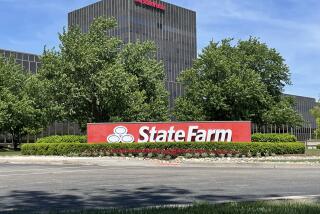State Farm Won’t Write New Homeowners Policies
State Farm General Insurance Co., California’s largest insurer of homes, said Monday it will no longer accept new homeowners business in the state because of a huge--and so far largely unexplained--surge in payouts over the last two years.
The company, which has watched its reserves against losses dwindle and its financial-strength ratings decline, said it will continue to cover its existing policyholders even if they move to new homes.
“We’re doing this to protect them,” company spokesman Bill Sirola said. “We’re still strong, but not at the level we want. And we’ve been paying $1.20 in claims and expenses for every dollar coming in.”
The shift won’t affect the company’s auto insurance business in the state.
State Farm General insures 20% of the state’s homes, 1.5 million policies in all. But after adding 40,000 new homeowner policies in California last year, it will cede new business in the foreseeable future to competitors such as Farmers Insurance Group and Allstate Corp.
With its exposure to natural disasters and a reputation for generating expensive lawsuits, California has always been an uncertain place for insurers. But it is also a market so huge that most analysts believe other insurers will aggressively go after business that State Farm gives up.
“Traditionally that’s what’s happened,” said Candy Miller, a spokeswoman for the Insurance Information Network of California, a trade group. “We’re much too big a market to ignore.”
The number of individual claims made to State Farm has not risen significantly, Sirola said, “but in the last couple of years the average claim cost has gone up as much as 30% in some areas.
“I wish I could give a simple answer why, but I can’t,” he said. The company believes a number of issues have boosted the average claim, including:
* Higher new and replacement construction costs. Builders are operating at full tilt to satisfy the demand for new housing, Sirola noted.
* More expensive home amenities demanded by customers. “We recognize that it’s become standard in a lot of homes to have things like marble countertops,” Sirola said.
* Higher water-damage costs. Water is necessary for mold to grow, and mold-related health claims are the fastest-growing complaint of homeowners--and the biggest uncertainty for insurers.
State Farm doesn’t break out mold claims, which have devastated insurers in Texas. But they are clearly rising with no easy way to forecast how high, the firm said.
“Anecdotes from the field are that costs for mold remediation and environmental air testing [for mold] are increasing far more than anything we could have anticipated,” Sirola said.
The higher water-damage figures also may reflect changes in home design such as washing machines on second floors and greater use of wood floors, he said.
Miller said State Farm’s decision wasn’t a surprise. “The handwriting was on the wall” given rising awards in lawsuits combined with mold liabilities, she said.
“The situation with mold is huge and unpredictable. Texas leads the country but California’s not far behind.” There are 10,000 lawsuits currently pending in the state involving mold claims, she said.
State Farm described the retrenchment as temporary, though it made no projections about when things might change. It has made similar cutbacks before, putting a national limit on growth in the early 1990s after Hurricane Andrew, and adopting another no-growth policy in California after the 1994 Northridge earthquake.
State Farm General hadn’t requested a California rate increase for years, until its losses shot up. State regulators approved a 6.9% increase late last year, another 6.9% hike early this year, and State Farm has another request for 6.7% pending.
But because it takes a year to phase in increases, the higher rates are only starting to boost the company’s premium income.
Meanwhile, the California firm’s policyholder protection fund--its capital held in reserve against losses--has fallen from $605 million to $425 million in two years, causing insurance safety-rating firm A.M. Best to recently cut its rating on the company to B-plus from the A level it has long held.
The parent company, State Farm Mutual Automobile Insurance Co. of Bloomington, Ill., lost a record $5 billion last year, hammered by increases in homeowner and auto claims as well as declines in investment returns.
The loss, on revenue of $40 billion, was the insurer’s largest ever. In 2000, State Farm had turned a profit of $400 million.
Because it is a mutual insurer (owned by policyholders), State Farm can’t raise money by selling stock in the public markets when its capital starts dropping, so it is forced to try to strengthen itself by limiting risk, Sirola said.
“It’s certainly not natural for us, and it has very serious implications for our agent contractors,” Sirola said. “But even they understand our financial necessity.”
More to Read
Inside the business of entertainment
The Wide Shot brings you news, analysis and insights on everything from streaming wars to production — and what it all means for the future.
You may occasionally receive promotional content from the Los Angeles Times.











